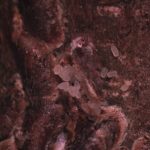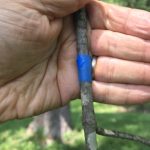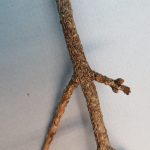Trees and shrubs can lose their leaves for many reasons. The maple tree in the cover photo is planted in a parking lot, and mulched incorrectly. The parking lot location gives the tree much less access to rainwater than a tree planted in a park-like pavement free location. Deep mulch piled like a volcano aggravates water problems because much of the rain will roll off rather than penetrate the soil at the tree base. Also, the base of the trunk is buried as if the tree has been planted too deeply. This can cause the tree to develop a second set of roots and wreak all sorts of havoc from girdling the trunk to making it even more difficult for a tree to get water from the soil. Scale insects can only make this tree’s problems worse.
Oystershell scales are among the more common armored scales that are attack trees and cause dieback. They can be easily identified by their oystershell shape. They feed on a wide variety of plants and shrubs, including maple, ash, dogwood, elms, and lilac. When they insert their long wiry stylet mouths into woody tissue to extract plant sap, they damage the vascular system and reduce production of new leaves on stems. Scale insects thrive when plants are stressed a lack of water and increased temperatures. Planting trees and improperly covering them in mulch can allow scales to rapidly build their number and outstrip the capacity of beneficial insects to control them.

Oystershell scales have a distinct shape. These scales winter as eggs that hatch into the crawling stage in late May when black locust is in bloom.
Oystershell scales can easily be recognized by the small, gray or brown oyster-like shells are present as bumps on branches and twigs. Unlike the closely related soft scales, these insects will be dry and not coated with a sticky liquid excrement. All life stages of this scale can be separated from the plant tissue by flipping them over with a fingernail. This flipping process will not rip the plant surface. If you remove a bump on a plant and the tissue rips, this means the plant has produced a gall or swelling in response to an insect or disease.
Scales winter as eggs beneath the scale cover of a female. Eggs hatch into crawlers in May after black locust is in full bloom. This is the stage where scales move to different parts of the plant, or are blown in the wind to nearby trees or shrubs. Once feeding commences, these insects become flattened and clear and are known as settled crawlers. A second generation of crawlers is produced from late July to early August. Partial third generations occur in some years.

Dark colored electrical tape can be wrapped around a twig sticky side out is a great monitoring tool.
Now is a good time to monitor for periods of crawler activity by wrapping scale infested twigs or branches with a single band of clear sticky tape or dark electrical tape so the sticky side faces out. Crawlers that emerge from scales are easy to see when they get stuck in the glue. Scales in the crawler stage are easily killed by pesticides.
Consider pruning out heavily infested dying branches. Foliar sprays of pyriproxifen, buprofizen, neem oil, or azadirachtin can be quite effective against crawling and settled stages of scales with minimal impact on natural enemies that help control this pest.
Links.
General information about scale insects How to fix problems with scale insects
Information about other scale insects Purdueplantdoctor.com
